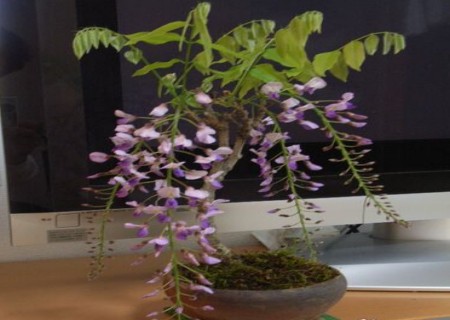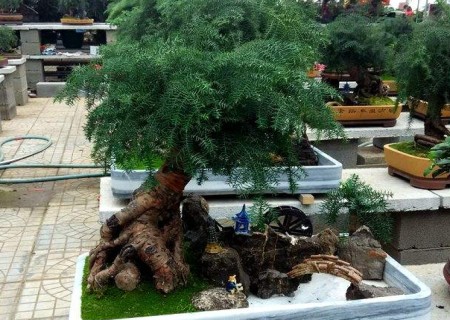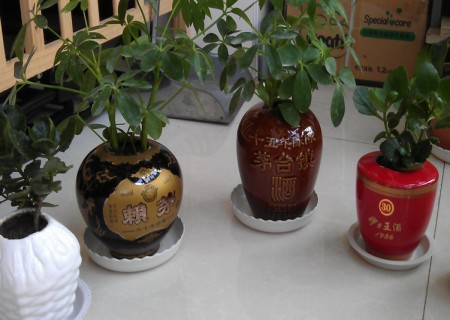The method of making Wisteria bonsai
Wisteria is gentle and bright in the vicissitudes and tenacity of the ancient walls; wisteria covers other people's eaves and hangs purple tassels, which virtually adds a bit of elegance to this family; wisteria builds dense flower sheds and flower racks to create an elegant and profound world. After cultivating wisteria, it will bear fruit in the shape of a pod, hanging between the branches, which is interesting. Sometimes it blossoms again in late summer and early autumn. The spikes of flowers and pods are set off against the green leaves like green feathers.

Wisteria, also known as rattan, Zhu Teng, is an excellent ornamental vine plant, generally used in garden scaffolding, courtyard design, purple flowers in spring, unique interest, suitable for planting in lakeside, poolside, rockery, Shifang and other places, with a unique style, bonsai is also commonly used. It has strong resistance to harmful gases such as sulfur dioxide and hydrogen oxide, and has the ability to adsorb dust in the air. It has been widely used in greening, especially in three-dimensional greening. It can not only achieve the effect of greening and beautification, but also play the role of increasing oxygen, cooling, reducing dust, reducing noise and so on.
How to make wisteria bonsai? The production and cultivation methods of wisteria bonsai are as follows:
1. Draw materials
It can be sown or cut, or the wild old root pile can be dug in the mountain field, and the billet can be processed in the pot after 1 year.
2. Upper basin
From February to March in spring, it is better to plant wisteria before long leaves. The basin soil is made of fertile, well-drained rotten leaf soil and garden soil; a deeper purple sand basin can be selected, which is square, rectangular, square, and oval in shape.
3. Modeling
Wisteria bonsai modeling is based on pruning, supplemented by banding, branches should be scattered up and down, monotonous should be avoided, and levels should be less rather than more. The forms of wisteria bonsai are curved dry type or oblique dry type, hanging branch type and cliff type, and can also be made into stone-attached type.
4. Watering
Watering should be based on the principle of watering thoroughly, proper watering during flower bud differentiation in August, normal watering in September and less watering after defoliation in late autumn.
5. Fertilization
In the growing period, it can be combined with watering and apply thin cake fertilizer once a month until the fertilizer is stopped from July to August; continue to apply fertilizer in September, but the times and concentration should be appropriately reduced; before flowering, phosphorus and potassium fertilizer can be properly increased.
6. Pruning
When wisteria sprouts in spring, the dense buds should be properly removed; when the new branches grow to more than 20 centimeters long, they can be cut off; at ordinary times, attention should be paid to cutting off long branches, diseased branches and weak branches at any time; and pruning should also be carried out during the dormant period. Pick the old leaves in September to promote the germination of new leaves.
7. Turn the basin
It is better to choose the time before the sprouting of early spring. Turn the basin every 2-3 years.
8. Pest control
Wisteria has fewer diseases and insect pests, such as aphids and leaf moths, etc., and the control method is to spray trichlorfon, emulsified dimethoate and other medicine solution.
Summary of operation points:
The transplantation of wisteria is mostly carried out before spring germination, first planted in tile pots or underground "raise billet", the plant should be pruned before planting, because it is a vine with a long trunk, which can be truncated in a suitable position, only the main branches and trunks needed for pile modeling are retained; its main roots are also very long, while fibrous roots and lateral roots are rare, and the overlong main roots can be cut short and more lateral roots can be retained.
After planting, it is preserved in a shelter to avoid the hot sun, and water is often sprayed to the tree trunk to promote the germination of adventitious buds on the old pile. After the new branches grow, erase the new buds and new branches that are not needed in modeling, and pay attention to the cultivation of transition branches, so as to make the proportion of bonsai branches and dry branches harmonious.
Time: 2019-05-26 Click:
- Prev

The method of making bonsai of Australian fir
Australian fir is one of the three largest ornamental trees in the world, which is famous for being very easy to maintain. Its bonsai is very popular because of its hanging roots, vigorous stem and luxuriant branches. Australian fir is green all year round, and it can be made into lovely bonsai, which is a plant that many people will raise in their homes.
- Next

The method of making potted wine bottle bonsai
Bonsai of various shapes and shapes are already common, such as dragon-style plum stakes, Jiaolong-style Luohan pine, oblique dry elm and so on, but if you want to associate these bonsai with unrelated wine bottles, you must be surprised or even surprised? Making wine bottle bonsai
Related
- Fuxing push coffee new agricultural production and marketing class: lack of small-scale processing plants
- Jujube rice field leisure farm deep ploughing Yilan for five years to create a space for organic food and play
- Nongyu Farm-A trial of organic papaya for brave women with advanced technology
- Four points for attention in the prevention and control of diseases and insect pests of edible fungi
- How to add nutrient solution to Edible Fungi
- Is there any good way to control edible fungus mites?
- Open Inoculation Technology of Edible Fungi
- Is there any clever way to use fertilizer for edible fungus in winter?
- What agents are used to kill the pathogens of edible fungi in the mushroom shed?
- Rapid drying of Edible Fungi

